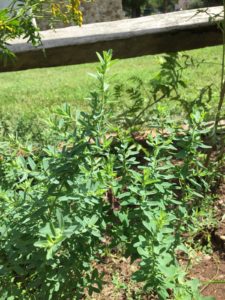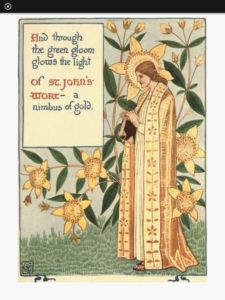 St. John’s Wort is a plant richly steeped in lore and practical medicine. Even the etymology of its name is full of tradition and celestial serendipity. Called the Wort of St. John, likely because of its blooming on the Summer Solstice corresponds with the Feast of St. John the Baptist on June 24, this plant’s strong association with the sun is apparent.
St. John’s Wort is a plant richly steeped in lore and practical medicine. Even the etymology of its name is full of tradition and celestial serendipity. Called the Wort of St. John, likely because of its blooming on the Summer Solstice corresponds with the Feast of St. John the Baptist on June 24, this plant’s strong association with the sun is apparent.
Petite yellow petals splayed from the center and a halo-like spray of stamens are rich with solar and heavenly symbolism. I adore its soft blue-green shading, and it will stain your fingers red when you bruise the leaves of a mature plant.
This is the first year the St. John’s Wort has been planted in the park garden, and it was started from seed. This plant does not flower in its first season, so I am looking forward to next year’s blossoms, when I will be able to make an infused oil (which is wonderfully red) of the aerial parts.
This was a common medicinal (and sometimes magical) remedy. German America, Christopher Sauer notes the remedy for burns: “wheat flour, silver earth, and white lead, three loths each of rose oil and St. John’s oil, and one loth of beeswax. Melt the wax and oils over a gently charcoal heat. When it is cool, add the other ingredients finely ground. Stir well together, and thus you will have a valuable salve.”
Here’s a little poetry to part with:
St Johns wort doth charm all the witches away.
If gathered at midnight on the Saints holy day.
And devils and witches have no power to harm
Those that do gather the plant for a charm.
Rub the lintels and post with that red juicy flower
No thunder nor tempest will then have the power.
I have sought the source of this poem to no avail. The most I found is Old English poem, 14th century.
And below is a beautiful lithograph from our time period, but too beautiful to resist:


